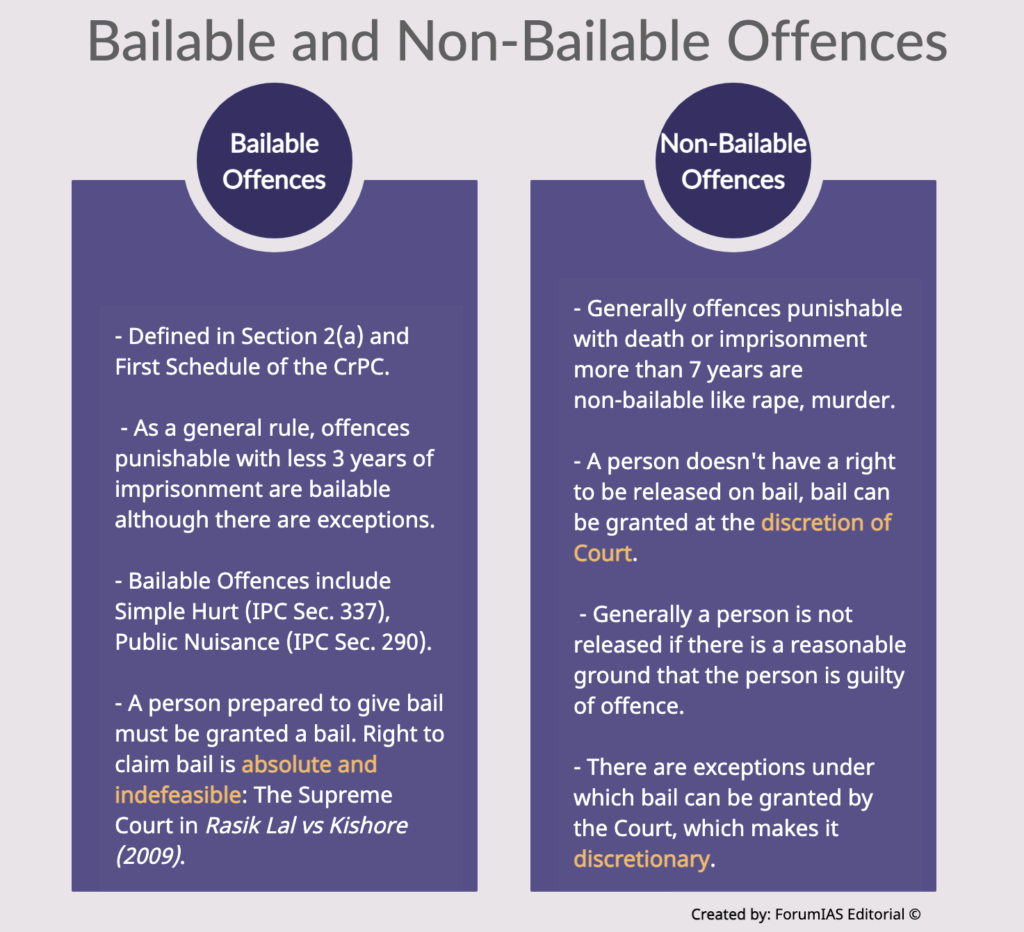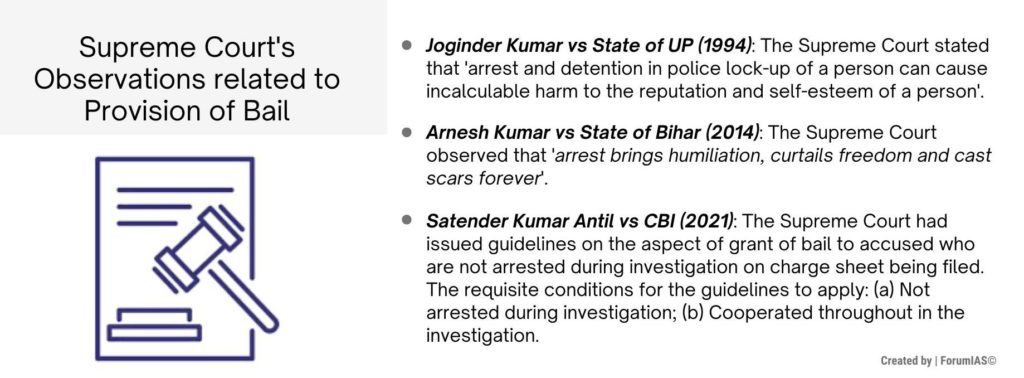ForumIAS announcing GS Foundation Program for UPSC CSE 2025-26 from 19 April. Click Here for more information.
Contents
| For 7PM Editorial Archives click HERE → |
Introduction
The Supreme Court (SC) has underlined the ‘pressing need’ for a reform in the bail law in India. The Court has called on the Government to consider framing a special legislation on the lines of the law in the United Kingdom (The Bail Act, 1976). The SC Bench made the remarks on the consideration of ‘abysmally low’ conviction rate. It said such detentions reflect a colonial mindset and. a ‘police state’. The remarks of the SC has come at a time when the number of under-trials in the prisons, and the pendency of cases in the judiciary have increased consistently over the last few years.
Bail is a fundamental aspect of any criminal justice system and the practice of bail grew out of the need to safeguard the fundamental right to liberty. In India’s legal system, the term offence has been categorised as bailable offences and non-bailable under the Code of Criminal Procedure (CrPC).
According to Section 436, bail is a right in bailable offences. The police or court, whoever has custody, is bound to release the accused following furnishing of a bail bond, with or without surety.
For a non-bailable offence, an accused cannot claim bail as a right. The discretion lies with the courts. In such cases, Section 437 empowers the Magistrate to deal with pleas, except for offences ‘punishable with death or imprisonment for life’.
A provision mandates the court to consider granting bail to an accused below 16 years, someone who is sick, or is a woman. The CrPC also lists provisions for the cancellation of bail.
What are the salient features of the Bail Act, 1976 (United Kingdom)?
The Act prescribes the procedure for granting bail. The key aim of the legislation is ‘reducing the size of the inmate population’. The Bail Act also has provisions for ensuring legal aid for defendants.
The Act recognises a ‘general right’ to be granted bail. Section 4(1) raises the presumption of bail by stating that the law applies to a person who shall be granted bail except as provided in Schedule 1 to the Act. For rejecting bail, the prosecution must show that grounds exist for believing the defendant on bail would not surrender to custody, would commit an offence while on bail, or would interfere with witnesses or otherwise obstruct the course of justice.
What is the need for a Bail Law in India?
Multiple and Dispersed Provisions: At present, provisions related to arrest and interrogation, issue of warrants and summons, execution of bonds and sureties, powers of police and courts, are dispersed across CrPC and various binding SC guidelines. A law collating these in one place can check arbitrariness in the discretion of the Courts.
Huge Quantum of Under-trials: Under-trials constitute more than 70% of the prison inmates and the proportion has risen consistently over the last few years. This indicates a very liberal use of arrest provisions. In many cases, persons are wrongfully arrested. Further, most of them are poor and therefore unable to secure monetary bail.
Colonial Mindset: The magistrates often ignore the rule of ‘bail, not jail’ due to persistence of a colonial mindset. This mindset is emboldened by old colonial laws which were drafted to serve the purpose of the British. The Code of Criminal Procedure (CrPC) was first drafted in 1882 and continues to be in use with amendments from time to time.
Delays in Bail application: Sometimes, bail applications are kept pending for months. Unnecessary arrest coupled with no bail is a double whammy. Appeals by the convicted are pending for decades in some HCs.
Lack of Uniformity: The SC observed that magistrates do not necessarily exercise their discretionary powers uniformly which violates Article 14 and 15 of the Indian Constitution. Uniformity and certainty in the decisions of the court is required as these are the foundations of judicial dispensation. In most cases, the courts do not record reasons for rejecting the bail.
What Guidelines have been issued by the Supreme Court?
A two-judge Bench issued certain clarifications to an older judgment delivered in July 2021 on bail reform (Satender Kumar Antil vs CBI). TThe Court observed that arrest is a ‘draconian’ measure that should be used ‘sparingly’. It lamented that bail continues to ‘be the rule and jail an exception’. he clarifications are a reiteration of several crucial principles of criminal procedure.
First, the Government should consider framing a separate law that deals with the grant of bail. It will help in reducing arbitrariness in grant of bail.
Second, it emphasized that even for cognisable offences, arrest is not mandatory and must be ‘necessitated’. Such necessity is drawn: (a) To prevent the committing of any further offense; (b) For a proper investigation; (c) To prevent the accused from either disappearing or tampering with the evidence; (d) To prevent any inducement, threat, or promise to any person, so as to dissuade that person from disclosing said facts either to the court or to the police officer; (e) When the presence of the accused is required after arrest for production before the Court and the same cannot be assured.
Third, there need not be any insistence of a bail application while considering the application under Section 88, 170, 204 and 209 of the Code. These sections relate to various stages of a trial where a magistrate can decide on release of an accused. These range from power of the magistrate to take bond for appearance (Section 88) to power to issue summons (Section 204). The Supreme Court held that in these circumstances, magistrates must routinely consider granting bail, without insisting on a separate bail application.
Fourth, bail applications have to be disposed of within 2 weeks except when provisions mandate otherwise. On anticipatory bail, it said a plea has to be decided within 6 weeks.
Fifth, Investigating agencies and officers have to comply with Sections 41 and 41A. It ruled that non-compliance with Sections 41 and 41A at the time of arrest will entitle the accused to bail. Section 41 deals with the arrest in a cognisable offence where punishment is imprisonment for a term which may be less than 7 years. Section 41A relates to the procedure of the notice of appearance before a policeman in cases where the arrest is not required. Notably, a police officer is required to record reasons for arrest or not to arrest in writing as per the rule.
Sixth, the SC directed State Governments and Union Territories to facilitate standing orders for the procedure to be followed under Sections 41 and 41A to avoid unwarranted arrests.
Seventh, the SC directed the High Courts (HCs) to identify under-trials who are unable to comply with bail conditions and take action to facilitate their release. After doing so, appropriate action will have to be taken in the light of Section 440 of the Code, facilitating their release. Under Section 440, the amount of bond shall not be excessive, and HCs and sessions courts may reduce the amount prescribed by the magistrate or a police officer. An exercise will have to be done similarly to comply with the mandate of Section 436A of the Code. Under this, a person imprisoned during investigation or trial shall be released on bail on completion of half of the jail term prescribed for that offence.
What more steps can be taken?
First, Disciplinary action against errant officers – in Police, Judiciary or Executive – may produce salutary changes.
Second, the Union and State Governments must comply with the directions issued by the Supreme Court with respect to the constitution of special courts.
Third, the High Courts in consultation with the State governments must undertake an exercise on the need for special courts. The vacancies in the position of Presiding Officers of the special courts must be filled up expeditiously.
Conclusion
A new bail law would take care of not only the unwarranted arrests, but also the clogging of bail applications before various Courts. It will help in bringing more clarity to magistrates thereby minimizing the scope of arbitrariness and improving administration of justice. It can also help in reducing the proportion of under-trial prisoners, and help preserve their fundamental rights
Syllabus: GSII, Important Aspects of Governance and Accountability, Issues Arising out of Design and Implementation of Policies.
Source: Indian Express, The Hindu, The Hindu, The Hindu, The Times of India,







